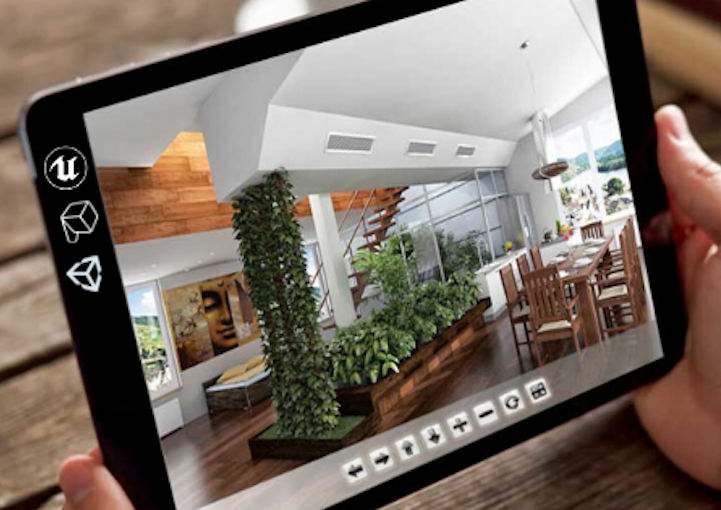How to Integrate Game Engines into Your e-Commerce and Digital Marketing Strategy

Video game development has been elevated to an art form with the advancements made possible with game engines like Unity and Unreal Engine. But game developers aren't the only ones using them. Enterprises are deploying the same technologies to develop digital showrooms, interactive 3D models, product configurators, and other brand experiences that capture attention and create demand.
Related Read: What is real-time 3D rendering (and why the future of digital depends on it)
The market for game engines is expected to expand at a compound annual growth rate of 10% through 2022. And Unity (valued to be worth $6 billion) and Unreal Engine (owned by Epic Games, which is worth an estimated $15 billion) are clearly leaders in the industry.
Unity has been focused on providing user-friendly tools and third-party plug-ins that streamline development, especially for smaller developers. For example, the VRTK plug-in enables the easy implementation of natural interactions without the use of code, while the Steam VR plug-in helps developers create room-scale virtual reality experiences with VIVE.
Unreal Engine has emphasized visual fidelity and enabled larger studios to create astonishing player experiences. Today, both engines have evolved so that either can fit within the scope of virtually any business project, and companies seeking to offer consumers new and exciting digital experiences are benefiting.
Interactive streaming 3D technology
Shopify, for instance, is using Unreal Engine to design and power virtual and augmented reality applications, creating tools like Thread Studio to allow shoppers to see how apparel would look and fit. Shopify knows that many consumers, especially younger, tech-savvy shoppers, are buying clothes online — but they’re also returning more than 75% of purchases. Thread Studio will enhance the shopping experience and cut down on returned items, which is a win for both buyers and sellers.
Apparel shopping is just one of countless applications for photo-realistic 3D streaming. Automakers like Audi and Chevrolet are using game engines to create experiences that drive marketing and sales through online real-time 3D visualization. Built using Unreal Engine, Chevy's Visualizer for its 2020 Stingray Corvette was a big hit with customers when it was launched in the summer of 2019, drawing more than 1.3 million visitors in less than a month. And Audi was a pioneer in offering a real-time photo-realistic 3D configurator as well.
Companies selling furniture and other home design products are seeing similar benefits of interactive 3D visualizations. For example, leading furniture sellers are using 3D renderings in their catalogs because they give customers views that photography simply can’t: sharper, more accurate colors; 360-degree visualizations; and interactive room scenes.
In the digital marketing world, engaging with customers and persuading them to hand over two extremely valuable resources — their attention and their information — is tricky business. Demonstrating product features through standard photography and video demos is no longer sufficient for companies looking to compel customer action. In one survey, 95% of respondents reported a preference for interactive 3D technology over traditional playback demos.
Related Read: 5 benefits of real-time 3D product configurators
How to integrate real-time 3D rendering technology into your business
If you want to achieve brand affinity and brand differentiation, build out sales pipelines, reduce customer acquisition costs, gain valuable predictive data for customer insights, and capture market share ahead of the competition, game engines and scalable, high-performance cloud streaming can help. Here’s how to start integrating the technology into your business strategy:
1. Evaluate use cases
Based on your customers and your product line, look for ways that interactive 3D can help you enhance the discovery and buying process. In some cases, a real-time product configurator for a single model or SKU might make sense. In others, a more comprehensive digital showroom could provide customers with extra utility, along with a memorable experience.
For maximum benefit, retailers should create 3D applications with game engines and make them accessible on their websites by easily embedding the configurator into a webpage and make it available across devices for shoppers anytime, anywhere. The latest advancements in real-time 3D streaming and cloud rendering make 3D configurators more widely accessible and provide a consistent, reliable user experience for as many buyers as possible.
Apparel sellers could create a personalized 3D avatar for trying on clothes, and furniture and appliance retailers could use an AR deployment to help customers see exactly how items would fit into a given space. These features can turn shopping into a gaming experience, personalizing the experience and leading to greater user interaction.
2. Find a partner
If you’re new to all this, find someone with experience to help you. A good creative digital agency or 3D visualization studio will have experience building with real-time 3D rendering platforms and the user-experience expertise needed to leverage a game engine's capabilities. If you’re building in-house or contracting with a game developer, decide whether Unity or Unreal would make more sense given your needs.
And companies also need a partner that can offer a fully managed interactive 3D streaming service and provide all the expertise and technical capabilities to manage cloud configuration and setup. PureWeb has a proven cloud platform that can scale to meet user demand, provides cost-efficient solutions, and has direct plug-ins with leading game engines Unreal and Unity to deliver ready-to-stream 3D models to any device, with no downloads required and minimal load times (less than 10 seconds, on average).
Let us handle the technical aspects of 3D cloud streaming while you work with your 3D visualization partner to create amazing content. PureWeb manages everything, including an entire series of processes, configurations, and more. Custom integrations with any e-commerce and inventory management software are also available through PureWeb's managed services.
3. Map out the user journey
Think about what a user’s first interaction with your digital experience will look like. What follows that interaction? The experience shouldn’t live in isolation. Instead, it should be one part of a fully integrated platform and omnichannel experience.
When a user finds your photo-realistic 3D display, ensure the streaming platform loads the interactive experience quickly and has no lag time. You want your system to be able to capture valuable user data as the user interacts with the 3D application in real time. Or you can offer a way for buyers to live-stream their game experience into a collaborative meeting space where they can interact with sales reps, designers, or family and friends.
Make it easy for them to capture shots of their creations and share them on social media, and provide an opportunity to book time to meet with a sales rep at the closest store or dealer. Capturing users' 3D configurations and sending them a personalized digital brochure with video of their dream creation would also provide a memorable marketing tool and impressive customer experience. Additionally, make sure the game data is in sync with other e-commerce and inventory tools so the buyer can be notified when the customized product is ready.
Related Read: How to build the ultimate digital marketing campaign for your 3D configurator
4. Set clear goals
Decide which metrics and key performance indicators you want to track in order to evaluate the effectiveness of the experience you create. If you’re offering an interactive 3D configurator online, you could measure relative increases in traffic, time spent on site, the number of configured products, new leads, or appointments booked.
For a larger, immersive VR showroom, you might count the number of app downloads or time spent in the digital showroom interacting with products. You’ll only know whether your experience was a success if you have predetermined goals in place.
5. Meet customers where they are
Make your experience accessible to as many people as possible. This means building it around the channels and tools they use the most, like the mobile web and social media. For those interested in more advanced tech, use VR and AR to let them interact with their favorite brands and products by experiencing a virtual, immersive showroom from the comfort of their homes.
Deploying through multiple touchpoints will help you drive more engagement across audience segments because prospective buyers expect more interactive and immersive experiences wherever they are. If they stand to benefit, chances are good that you will, too. Modern game engines allow you to create something remarkable for everyone.
PureWeb offers interactive streaming solutions for real-time 3D game applications and photo-realistic renderings made available on any device. If you're interested in learning more about how PureWeb can help you with deploying your company's interactive 3D experience, contact us to discuss your real-time project.


